Cyclify India is reader-supported! We may receive an associate commission if you purchase through one of the Amazon Associate links on this page! Continue Reading…
The letter “Mag” in “mag wheels” refers to magnesium. Because they are lightweight and look great on the proper kind of bike, magnesium wheels were formerly very common.
Bicycle wheels come in a variety of styles, including spoke, alloy, and mag wheels. We will examine what mag wheels on a bike are as well as the distinctions between alloy & spoke wheels in this following article.
Although the design has subsequently gained popularity, current “mag” wheels are typically composed of carbon fiber, aluminum, or alloy since these materials are more durable and long-lasting than magnesium.
Mag wheels are utilized on a variety of race & sports bikes because of their lightweight design.
To learn the benefits and drawbacks of mag alloy wheels over spoke wheels, read the entire article.
Table of Contents
What are Mag Wheels?
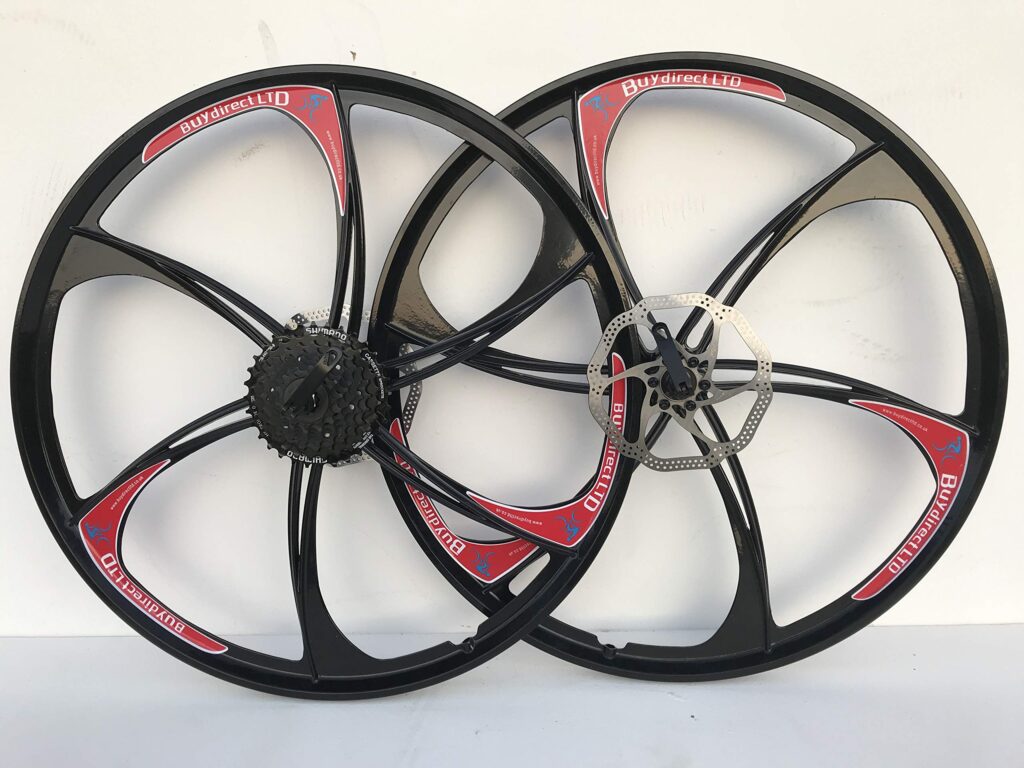
There won’t be a joint in the alloy wheels because it is a single metallic block. Because alloy wheels are composed of light metal alloys, particularly magnesium or aluminum, they are lightweight.
As you may know, alloy wheels are used on sports bicycles since they must be lightweight to maximize speed.
As a combustible metal, magnesium burns readily. It is not advised to use mag alloy wheels on street bicycles for this reason.
Benefits of Mag Wheels
- The mag alloy wheels weigh less.
- Racing bikes are perfect for racing because of their lightweight alloy wheels.
- Because alloy wheels are constructed of single block metal, they are manufactured by machines without the need for human labor.
- Alloy wheels are the only option for bicycles with large, wide tires because of their rigidity.
- Modern styles & designs abound for alloy wheels.
Drawbacks of Mag Wheels
- They are quite pricey wheels.
- On-off rads do not function correctly with alloy wheels.
- If you go off-road or make a hard landing, alloy wheels might flex.
- Because alloy wheels are rigid, they are not utilized in steep terrain.
- Issues with durability arise with Mag alloy wheels.
What are Spoke Wheels?
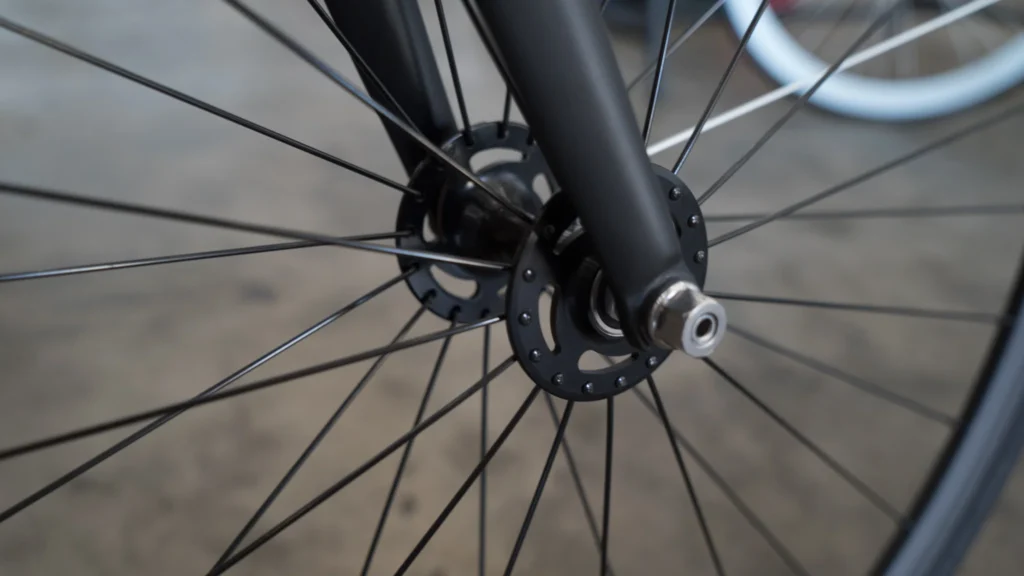
The primary hub, which houses the disc brake, is where the spokes are fastened. In order to enable rubber tires to grip, the spoke wheel structure is strong and flexible throughout, with numerous joints connecting the spokes to the rim.
Stainless steel, steel, aluminum, carbon fiber, and titanium are used to make spoke wheels. Its maintenance cost is low and they are very durable. These are a few of the best bicycles with spoke wheels.
There are usually 30 to 36 spokes in a standard bicycle wheel.
Benefits of Having Spoke Wheels
- 26 inches Spoke wheels measuring are longer-lasting, more robust, and more resilient.
- Notable for its timeless and vintage appearance.
- Adventure and off-road cycling employ spoke wheels.
- Spoke wheels are inexpensive to maintain and are simple to fix.
- Spoke wheels are incredibly flexible because of their steel characteristics.
- Riders experience reduced shock impact because to the steel spokes and rims.
- Spoke wheels have a great ability to absorb stress, which lessens the impact of shock on riders.
Drawbacks with Spoke Wheels
- Modern looks and diverse designs are not available for spoke wheels.
- In spoke wheels, tubeless tires are not utilized.
- The process of patching punctures takes longer.
What Is The Difference Between Spoke Wheels And Alloy Wheels
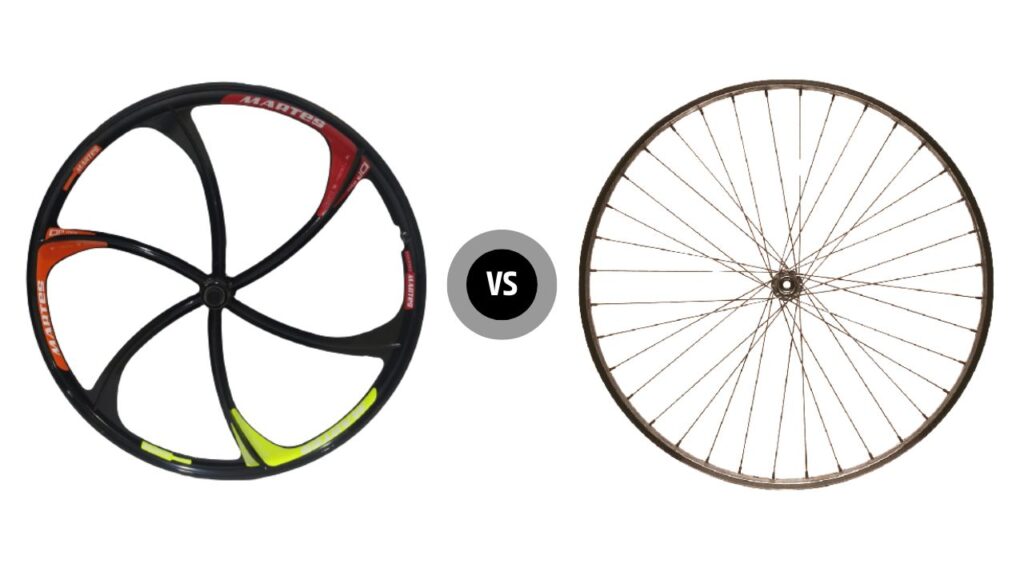
Both spoke and mag alloy wheels meet all the requirements to be considered high-quality bike wheels, but they also differ significantly in a few key areas. And you may be asking yourself, what distinguishes these two from one another?
Wheel structure is the primary distinction between spoke and mag alloy wheels. Due to their curved steel rim construction, spoke wheels are hefty since they are directly attached to both the inner and outer hubs.
Additionally, the rims have tiny cracks screwed into them. In contrast, carbon wheels are cast and forged to create alloy wheels. Mag Alloy wheels are lighter than spoke wheels because they are devoid of any gaps or holes.
Both kinds of wheels have further differences outside of these sections. As in
Design
It is the most crucial element. Magnesium wheels feature a chic and contemporary appearance. You get to add individuality to your bike and attract attention from onlookers, since that’s all that counts, right? (Joking)
Lightweight
In general, a bicycle wheel made of magnesium alloy will weigh less than its traditional spoked counterpart. A spoked wheel typically weighs between 1.5 and 2 kg (3.3 and 4.4 lbs), but a magnesium wheel would weigh between 1 and 1,5 kg (2.2 and 3.3 lbs).
These figures, of course, must be interpreted with some caveat as they are based on the rim’s diameter.
Lighter wheels will often perform better in terms of speed and make cycling much simpler to handle.
Sturdiness and longevity
The density of mag bike wheels is low (1.74 g/cm3). They have less distortion and can efficiently absorb shocks.
Thanks to vibration absorption, the passenger experiences a safe and comfortable ride. He or she can also ride a bike with little difficulty.
Granted, these mag wheels often have a longer lifespan than more conventional wheels, particularly when utilized on city roads.
Anti-corrosion Safeguards
Remember that pure magnesium alloy has a low level of corrosion resistance. It must thus be combined with other metals to form an alloy in order to prevent corrosion. Actually, the other metals it is combined with will serve as shields, enhancing the alloy’s overall properties.
Repair potential
Although they may be fixed, bike mag wheels require more time to repair than spoked wheels. On the other hand, it is not feasible to straighten a bent wheel.
Cost
Alloy wheels are expensive. The cost of magnesium wheels is often a little greater than that of more traditional spoked wheels, however this is justified by the materials utilized and the benefits that magnesium alloy wheels may provide.
It goes without saying that not everyone can afford this option.
What about maintaining a bike with mag wheels?
Oh my gosh, what a delight maintenance is. Magnesium alloy wheels are much easier to clean than spoked wheels. It only takes a small tap to release you.
Thus, maintaining clean, well-maintained wheels requires very little work and time.
Which bicycles use mag wheels?
Strong and just marginally susceptible to deformation is magnesium alloy. Although MAG wheels are great for commuting bikes and are actively utilized by professional cyclists, they are not appropriate for usage in harsh weather. Such wheels are found on several really great fixies that I’ve seen!
Though I believe these will fit better on a BMX bike, for example, other people may picture mountain bike mag wheels.
What sort of brakes are on mag wheels bikes?
Usually, the wheels come with a pair of disc brakes installed to prevent abrasion to the coating applied to the mag wheels. In fact, rim brakes run the danger of damaging the wheel too soon (the article’s photo shows rim brake-caused scuffs on a bike with mag wheels).
Why are there Mag Wheels on some Cheap Bikes?
As we just discussed, mag wheels are often very costly. Nonetheless, it’s likely that you’ve noticed some cycles with mag wheels fitted to them. Why is it the case?
Mag wheels provide low budget bikes with a premium and stylish appearance, which is especially important for sales of lower-priced models, considering they rely on flashy things to make people buy them.
Even though I would advise purchasing a normal wheelset for a less expensive bike, it’s fantastic if mag wheels encourage someone to start riding a bike!
Does your Bike Require Mag Wheels?
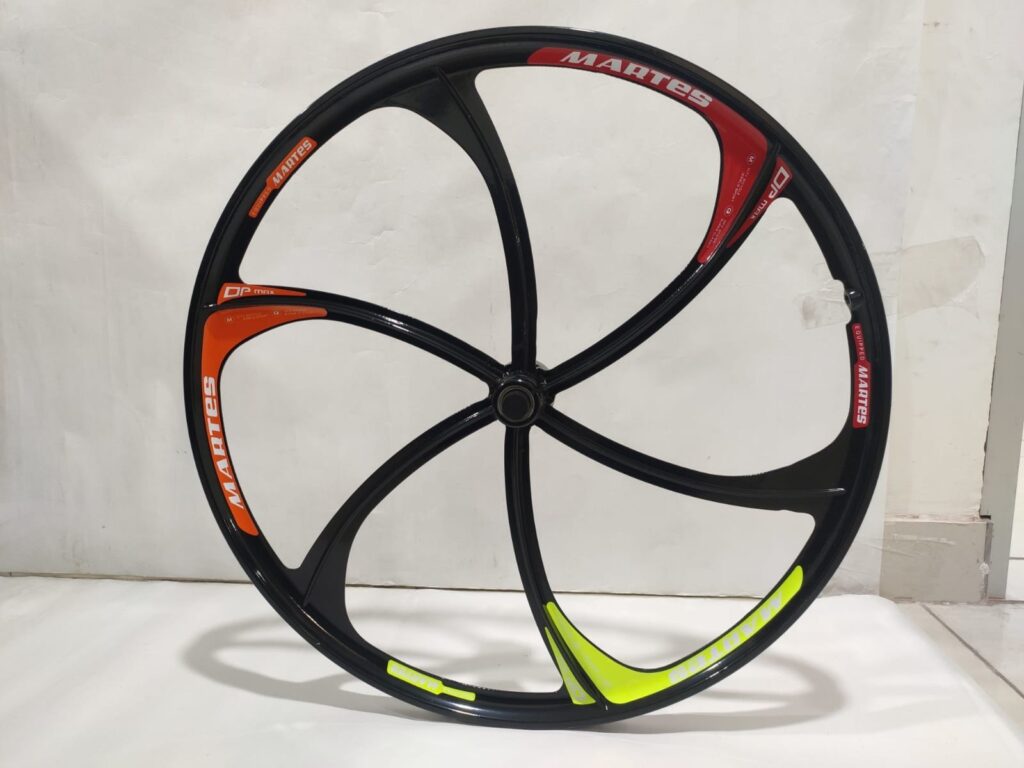
Though they are a little more costly than spoked wheels, mag wheels undoubtedly have a fantastic appearance and are very cool.
Depending on your riding style and intended riding location, spoke or mag wheels may be necessary for your bicycle. In the event that you intend to ride in mountainous or rough terrain, spoke wheels would be a more suitable choice.
The shock absorption feature of mag alloy wheels is pretty much nonexistent. Please share the outcome if a spoke wheel barely touches the road.
Shock is initially absorbed by the tire’s rubber, after which it moves to the rim and spokes, and finally to the suspension of the bicycle.
So make an informed decision based on your needs and preferences.
Final Thoughts on Bicycle Mag Wheels vs Spoke Wheels
We’ve now covered the distinctions between Mag Wheels vs Spoke Wheels, as well as what are mag wheels on a bike and their benefits & drawbacks.
However, they are not necessary for performance purposes, and maintenance on them is far simpler than on ordinary wheels. They can, in fact, significantly improve your bike and let you make some minor changes!
It all comes down to the wheels’ longevity and stiffness in the end. Spoke wheels are long-lasting and alloy wheels are stiff.
Based on your interests and the conditions in the region, you may select the best option. Gents! Kindly inform us about the kind of wheels on your bicycle. Post a comment below!
Now that you know what mag wheels are, you may utilize them to get a pretty cool effect if your usage and money let it.

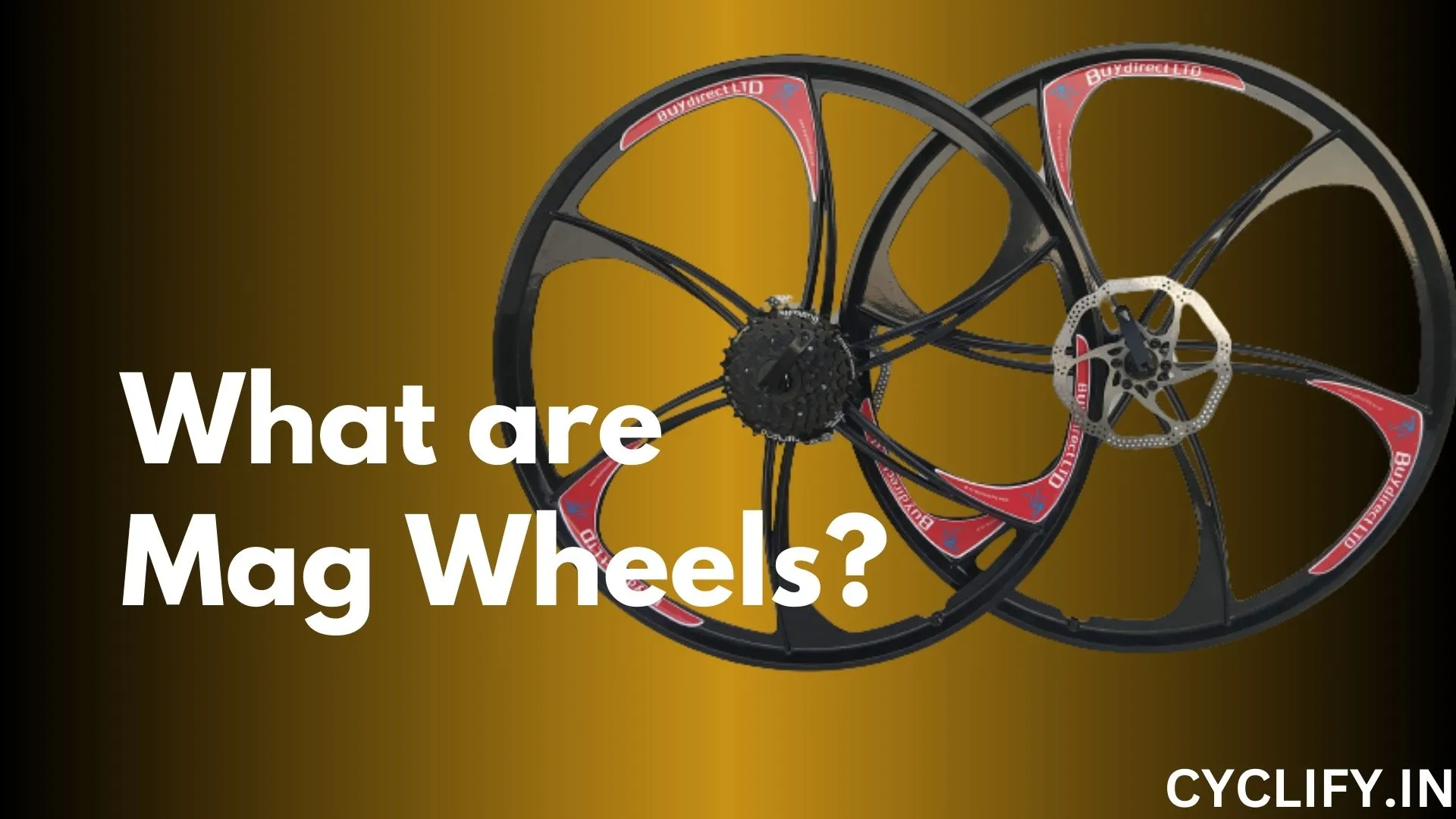
0 Comments